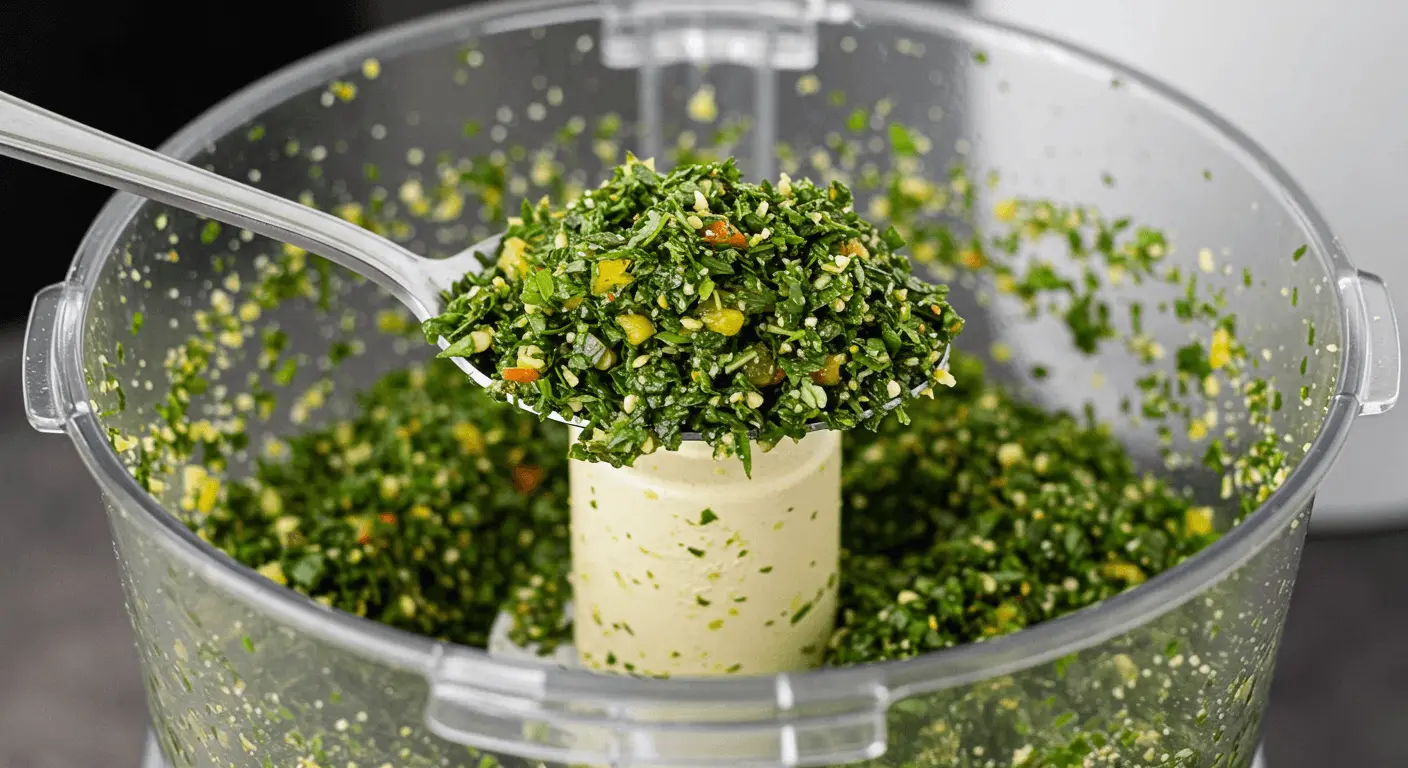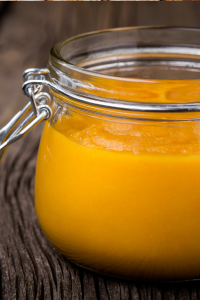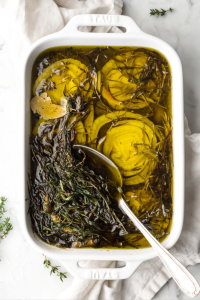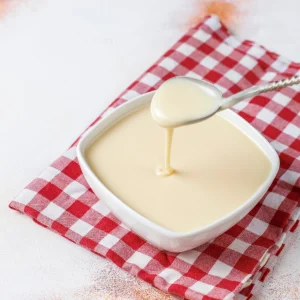Exploring Caribbean cuisine, you’ll find green seasoning is key. It’s a mix of herbs and spices used in Trinidad, Guyana, and Puerto Rico. Making your own green seasoning adds fresh flavor to many dishes. We’ll show you how to make delicious green seasoning for your meals.
Key Takeaways
- You can make your own homemade green seasoning using a variety of herbs and aromatics.
- Caribbean green seasoning is a fundamental component of Caribbean cuisine, used to add flavor to meats, seafood, and vegetables.
- Green seasoning can be stored in the refrigerator for up to 2 weeks or frozen for up to 6 months.
- The recommended usage of green seasoning varies depending on the dish, but a general guideline is 2 heaping tablespoons per pound of meat.
- By following a simple recipe and using the right ingredients, you can create your own delicious Caribbean green seasoning to elevate your meals.
- Caribbean green seasoning can be customized to suit your personal taste preferences, allowing you to experiment with different herbs and spices.
- Using high-quality ingredients, such as fresh herbs and olive oil, is essential for creating a flavorful and aromatic green seasoning.
Understanding Caribbean Green Seasoning
Caribbean green seasoning is key to Caribbean food, showing the area’s rich culture. Each island has its own twist on the recipe. It’s made from fresh herbs, spices, and peppers, giving it a unique taste.
In Trinidad and Tobago, green seasoning is used in many dishes like curries and stews. The mix includes cilantro, parsley, thyme, and scotch bonnet peppers. It also has garlic, ginger, and lime juice for a fresh, aromatic flavor.
Cultural Significance in Caribbean Cuisine
Caribbean green seasoning is more than food; it brings people together. It’s a sign of welcome and friendship in many places. Serving it to guests is a way to show hospitality.
Regional Variations
Even though it’s shared, Caribbean green seasoning varies by island. Jamaica’s mix might be different from Barbados’ or St. Lucia’s. This creates a variety of tastes and textures.
Traditional Uses
Caribbean green seasoning is used in many ways. It’s a marinade, rub, or seasoning for meats, seafood, and veggies. It’s also in soups, stews, and curries, and as a flavor booster for grilled or roasted foods.
Essential Ingredients for Green Seasoning
To make the best green seasoning blend, choose high-quality ingredients. The freshness and quality of these ingredients greatly affect the flavor. Simply Recipes says key ingredients include onion, garlic, pepper, scallions, culantro, thyme, and basil.
When picking your ingredients, focus on these important parts:
- 8 scallions or green onions
- 1 bunch cilantro
- ½ bunch parsley
- 8-10 culantro leaves (optional)
- 13-15 garlic cloves
- 12-13 sprigs of thyme
These will help you make a balanced and tasty green seasoning blend. Remember, the quality of your ingredients is key to the best blend.
Using fresh and high-quality ingredients makes your green seasoning not only tasty but also healthy. With the right mix, you can make a unique and flavorful blend that will make your dishes better.
Required Tools and Equipment
To make homemade green seasoning, you’ll need the right tools. A blender or food processor is best. It helps blend ingredients well and control the texture. Knowing how to make green seasoning means having the right appliances for the right consistency.
Here are the key tools and equipment you’ll need:
- A blender or food processor
- A cutting board for chopping ingredients
- A knife for mincing and dicing
- A storage container for storing the green seasoning
You might also want a grinder or mortar and pestle for extra texture and flavor. With the right tools, you can make a delicious homemade green seasoning. Use it in many dishes.
Always follow food safety guidelines when handling and storing your green seasoning. With the right tools, you can enjoy Caribbean flavors at home.
How to Make Traditional Green Seasoning
To make traditional green seasoning, start by preparing your ingredients. Chop and blend fresh herbs like cilantro, parsley, and celery. Also, include green onions, garlic, onion, ginger, and thyme. Simply Recipes suggests using a mortar and pestle, but a blender works well too.
Getting the right mix of ingredients is crucial. Use about 2 tablespoons of green seasoning per recipe. You can tweak this amount based on your taste and the dish you’re making.
Ingredient Preparation Steps
First, wash and chop the herbs. Peel and chop the onion, garlic, and ginger. Use a food processor to finely chop, but don’t overdo it. Aim for a smooth blend full of flavor.
Blending Technique
Now, blend the chopped ingredients together. Add water if needed for smooth blending. A bit of oil can also enhance the flavor. Your green seasoning should be vibrant and smell fresh.
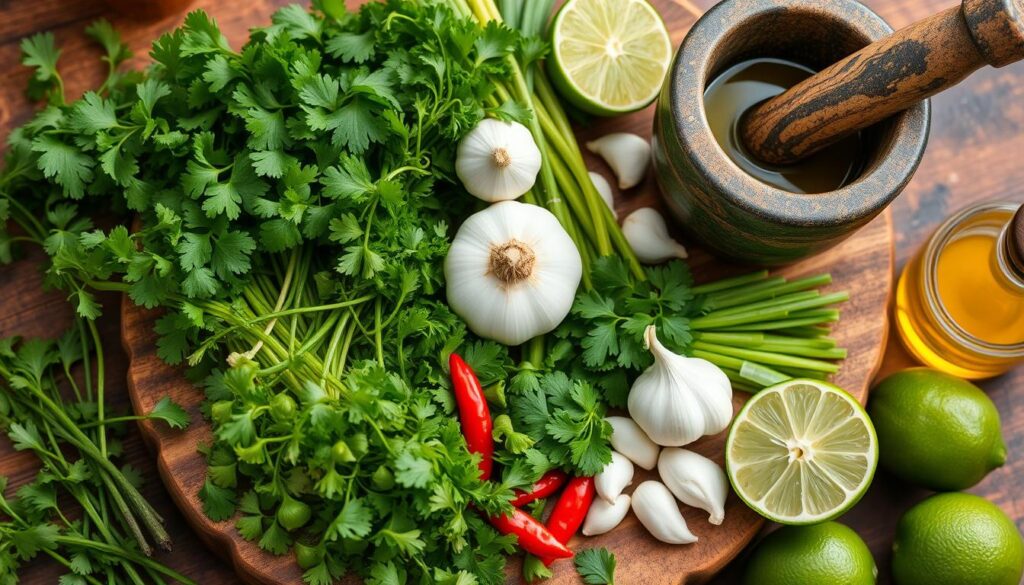
Consistency Adjustments
You can adjust the green seasoning’s thickness. Add less water for a thicker blend, and more for a thinner one. Adjusting the oil can also change the consistency.
Follow these steps to make a tasty green seasoning. It’s great for stews, sauces, or marinades. It adds a fresh flavor to your cooking.
Storage and Shelf Life
Keeping your caribbean green seasoning fresh is key. Store it in an airtight container in the fridge. This way, your green seasoning can last up to 2 weeks in the fridge or 6 months in the freezer.
Here are some tips for storing your green seasoning:
- Keep the seasoning in the fridge’s back, not the door, for longer life.
- Use white vinegar instead of water to extend its shelf life.
- Freeze it in reusable bags or ice cube trays for longer storage.
By storing your caribbean green seasoning right, you can enjoy it longer. Use it to flavor many dishes. Always check for spoilage before using.
Best Ways to Use Your Green Seasoning
Now that you’ve made your green seasoning, it’s time to use it. You can try different amounts to find the right mix for your meals. It makes meats, fish, and veggies taste better.
Start by adding it to marinades and rubs. Use 1-2 tablespoons for every pound of meat. You can change this based on what you like and what you’re cooking.
Marinades and Rubs
Green seasoning is great in marinades and rubs. It brings fresh flavor to your food. Mix it with lime juice, garlic, and herbs for a special blend. For chicken or fish, try 2 tablespoons of green seasoning, 1 tablespoon of lime juice, and 1 clove of garlic.
Cooking Applications
Green seasoning is also good in soups, stews, and sauces. It adds depth and flavor. For roasted veggies, it makes them taste even better. Start with 1 teaspoon and adjust to taste.
Quantity Guidelines
Using the right amount of green seasoning is key. Use 1-2 tablespoons for every pound of meat. Adjust this based on your taste and the dish you’re making. Remember, a little goes a long way.
Here’s a quick guide on using green seasoning:
| Usage | Quantity |
|---|---|
| Marinades and rubs | 1-2 tablespoons per pound of meat |
| Cooking applications | 1 teaspoon (adjust to taste) |
| Storage | Refrigerate for up to 2 weeks or freeze for up to 3 months |
By following these tips and trying different amounts, you can make the most of your green seasoning. Your dishes will impress everyone.
Troubleshooting Your Green Seasoning Blend
When you make homemade green seasoning, you might run into some common problems. These can mess with the taste and feel of your mix. We’ve got some quick fixes to help you get back on track. Whether you’re starting from scratch or trying to improve your recipe, these tips will help you get the best results.
Some common issues with Caribbean Green Seasoning include uneven flavor or texture. This might happen if the ingredient ratio is off or if you blend it wrong. Try tweaking the ingredient amounts or blending it longer to fix this.
Common Issues and Solutions
- Inconsistent flavor: Adjust the ratio of ingredients, such as adding more cilantro or thyme to taste.
- Texture issues: Blend the mixture for a longer period or add a little more water to achieve the desired consistency.
- Too spicy: Reduce the amount of scotch bonnet pepper or omit it altogether for a milder flavor.
By following these simple tips and troubleshooting common issues, you’ll be able to create a delicious and authentic homemade green seasoning that elevates your dishes to the next level. Remember to always taste and adjust as you go, and don’t be afraid to experiment with different ingredients and ratios to find your perfect blend.
With a little practice and patience, you’ll be a master of making your own green seasoning in no time. Whether you’re using it to marinate meats, add flavor to soups, or simply as a seasoning for your favorite dishes, the possibilities are endless. So go ahead, get creative, and enjoy the process of learning how to make green seasoning that’s all your own.
| Ingredient | Quantity |
|---|---|
| Cilantro | 1/2 bunch |
| Thyme | 10 sprigs |
| Garlic | 10 cloves |
| Scotch bonnet pepper | 1 pepper |
Customizing Your Green Seasoning Recipe
Exploring caribbean green seasoning opens up a world of possibilities. You can make your own special blend by tweaking a few ingredients. Whether you like it mild or bold, you can adjust it to your liking.
To change up your green seasoning, play with the ingredient amounts. Want more herbs? Add more chadon beni or cilantro. For a milder taste, cut down on scotch bonnet pepper or skip it.
Adding new ingredients can also spice up your seasoning. Try lemon juice, garlic, or ginger. You can also mix in thyme or oregano for a unique flavor.
Here are some tips for customizing your green seasoning recipe:
- Start with a base recipe and adjust the ingredient ratios to suit your taste preferences.
- Experiment with different ingredients, such as herbs, spices, and citrus juices.
- Consider adding a bit of heat with scotch bonnet peppers or other hot peppers.
- Don’t be afraid to try new combinations and flavor profiles.
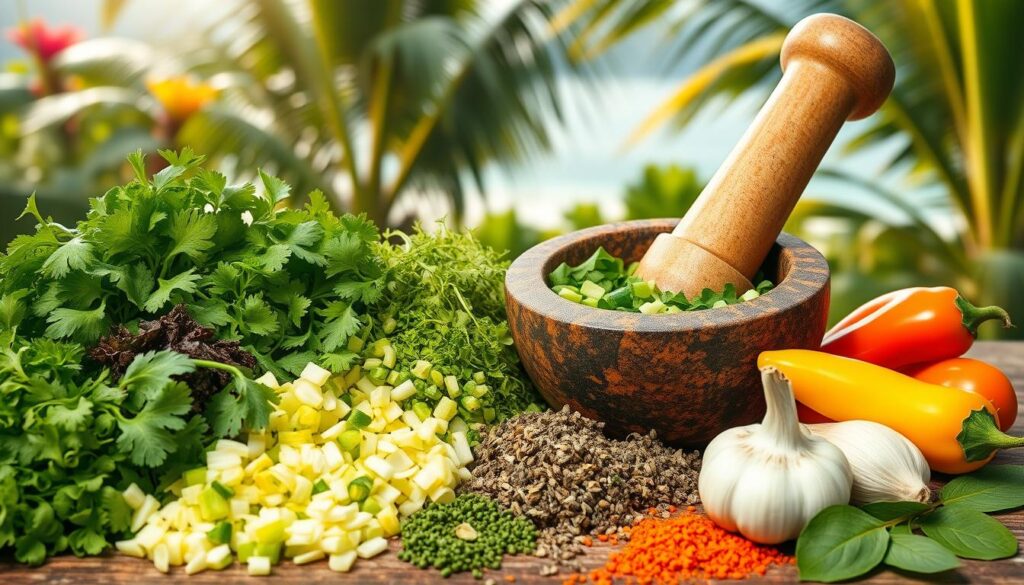
Customizing your green seasoning lets you create a unique flavor that’s all yours. Use it as a marinade, rub, or seasoning. Your caribbean green seasoning will make any dish more exciting. So, get creative and explore endless possibilities!
| Ingredient | Quantity |
|---|---|
| Olive oil | 4 tbsp |
| Lemon juice | 2 tbsp |
| Salt | ½ tsp |
| Green onions | 4, chopped |
| Garlic | 2 cloves |
Conclusion: Mastering Your Caribbean Green Seasoning
Through this guide, you’ve learned how Caribbean green seasoning brings depth to many dishes. It’s a key ingredient that adds authenticity. Now, you can make your own homemade green seasoning and enjoy the Caribbean’s vibrant flavors.
Experimenting with herbs and spices is key to mastering Caribbean green seasoning. Try different mixes to find your favorite. This way, you can create a unique blend that’s all yours.
This green seasoning is great for meats, seafood, and veggies. It’s a must-have in your kitchen. Dive into the Caribbean’s rich flavors and keep improving your Caribbean green seasoning skills.
FAQ
What is Caribbean Green Seasoning?
Caribbean Green Seasoning is a mix of fresh herbs, spices, and aromatics. It’s key in Caribbean cooking. It adds flavor and depth to many dishes.
What are the key ingredients in Caribbean Green Seasoning?
The main ingredients are herbs like cilantro, parsley, and thyme. Spices like garlic, onions, and peppers are also crucial.
How do I make traditional Caribbean Green Seasoning?
To make it, prepare and blend the fresh ingredients carefully. Use a blender or food processor for the right consistency.
How should I store Caribbean Green Seasoning?
Store it in an airtight container in the fridge or freezer. This keeps it fresh and flavorful, depending on how soon you plan to use it.
How can I use Caribbean Green Seasoning in my cooking?
It’s very versatile. Use it as a marinade, rub, or seasoning for meats, seafood, veggies, and rice. Try different amounts and flavors to find your favorite.
What are some common issues that can arise when making Caribbean Green Seasoning?
Issues like uneven flavor or texture, color changes, or a short shelf life can happen. Adjusting ingredients, blending, or storage might solve these problems.
Can I customize my Caribbean Green Seasoning recipe?
Yes! Caribbean Green Seasoning is all about personalizing it. Mix and match herbs, spices, and aromatics to create your perfect blend.

